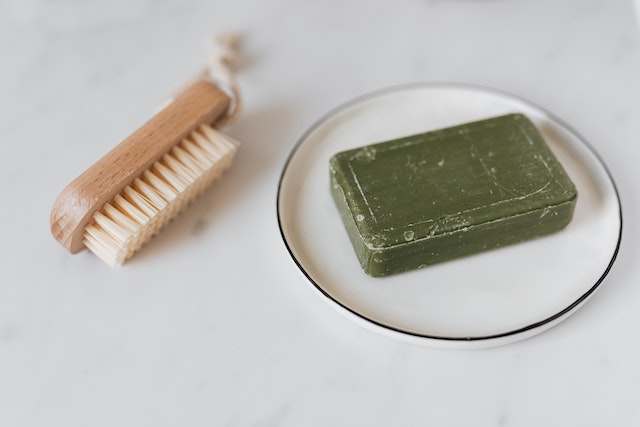
When did people start using soap? In 2800 BC in Babylonia.
Archaeologists have found soap-like materials in clay cylinders that have been dated to 2800 BC. The tablets are inscribed with “fats boiled with ashes”. Soap is first mentioned on a Sumerian clay tablet, which has a formula for how to make it. It says that you have to heat a mixture of oil and wood ash.
The first soap was probably discovered by accident. People who prepared meat ended up with a lot of fat on their butchering tools. Cleaning fat off something with water is impossible, so they would have to wipe or scrape it off. Probably through wiping their tools on different things, these butchers would have realized that wet wood ash cleaned the grease off their tools.
When wood ashes get wet, they produce lye. Lye is sodium hydroxide. Sodium is an alkali metal, which are soft, highly reactive, alkaline metals. Hydroxide is a connected oxygen and hydrogen atom. Wood ash is mostly potassium carbonate, and when you mix it with water, you add the oxygen and the hydrogen, and you get sodium hydroxide. Lye, or sodium hydroxide, is very good at attaching itself to fat. You cannot wash fat off something with water because oil is hydrophobic (water hating), and water is hydrophilic (water loving). That means fat molecules are repelled by water molecules and water molecules will only stick to water molecules. Lye molecules have a polar end, which is hydrophilic, and a non-polar end, which is hydrophobic. When butchers washed their greasy tools with wet ash, the hydrophobic ends attached to the fat molecules and the hydrophilic ends attached to water molecules, meaning water could wash off the fat. The lye forms a bridge between the fat and the water. This is why it is dangerous to get lye on your skin. It pulls the fat molecules out of your skin and can cause a bad burn.
Early people would probably have learned this through trial and error. When the lye mixes with the fat, it forms a simple soap, but these people didn’t use it as a soap. They just rinsed it off. There doesn’t appear to have been a connection with the soap and other uses.
The soap-like materials found in Sumeria probably came from a textile factory. The Sumerians invented textile factories and they almost had a production line made of slaves, debtors, and cheap labor. Sheep came in one end. They were shorn, the wool was woven, dyed, and textiles were produced. One textile factory could produce 400 tons of wool in a year. Before wool can be dyed, the fats have to be removed from it. If the wool is left with the lanolin fats, the dye won’t penetrate it. The workers used ash and water again to remove the grease.
The big jump between 2800 BC and 2500 BC seems to have been the realization that the fat was just as important as the ash. If animal fat was added to a bucket of ash and water, it would produce a liquid soap, which could be used to wash many more things than just wool or butchers’ tools.
Soap production improved and the Egyptians in 1550 BC made soap from animal fats, vegetable oils, and soda ash. In the Southern Mediterranean, soap was made from olive oil, alkali ashes, and quicklime. It was boiled for days and then poured into molds to set. It was cut into smaller pieces. This is possibly the first use of hard soap.
The hard, scented soaps, more recognizable as the ones we use today, were created in the Middle Eastin approximately the 9th century, and then carried through Europe by traders. Soap-making became an established industry. Soap from Middle Eastern countries, such as Damascus, were prized luxuries. Soap making spread to Europe, but it was still a luxury. It was only with the Industrial Revolution, when soap could be mass-produced, that it became cheap enough and common.
Over the millennia, soap has saved lives because it removes bacteria and viruses as well as fat. Nobody knew that until fairly recently. Soap is very effective at destroying bacteria. Some bacteria and viruses have lipid membranes that contain lots of the proteins they use to enter cells to infect them. Soap surrounds the bacteria or the virus and the hydrophobic ends of the soap molecules try to escape the water and force themselves into the lipid membrane, tearing it apart and killing the virus or bacteria, This is why we should always wash our hands. And this is what I learned today.
Photo by Karolina Grabowska: https://www.pexels.com/photo/green-soap-in-a-ceramic-plate-4194714/
Sources
https://www.nytimes.com/2020/03/13/health/soap-coronavirus-handwashing-germs.html
https://www.farmersalmanac.com/the-history-of-soap
https://medium.com/solvaygroup/squeaky-clean-how-soap-makes-it-happen-b0b6d401b2de
https://en.wikipedia.org/wiki/Hydroxide
https://en.wikipedia.org/wiki/Alkali_metal
https://en.wikipedia.org/wiki/Lye
https://ravensroots.org/blog/makinglye
https://www.britannica.com/story/how-does-soap-work
https://time.com/5831828/soap-origins/
https://en.wikipedia.org/wiki/Soap
https://www.cleaninginstitute.org/understanding-products/why-clean/soaps-detergents-history
